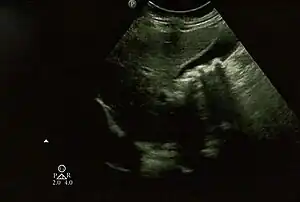Biliary pseudolithiasis
Biliary pseudolithiasis is an unusual complication of ceftriaxone where the drug complexes with calcium and mimics gallstones.[1][2] It is reversed when ceftriaxone administration is stopped.[2] It was first described in 1988 by Schaad et al. as "reversible ceftriaxone-associated biliary pseudolithiasis".[2][3] Ceftriaxone has been frequently associated with biliary sludge or biliary pseudolithiasis in subsequent reports.[3] Ceftriaxone is excreted primarily through the urine, but also through the bile, up to 40% of its excretion, with concentrations in the bile 20-150 times higher than in the serum.[3][4] It forms a calcium salt in the gallbladder, which can exceed its solubility and create precipitates that resemble gallstones on ultrasonography.[3] The incidence of pseudolithiasis in children treated with ceftriaxone is up to 25%, but most patients are asymptomatic.[3][4] Risk factors for biliary pseudolithiasis include age greater than 24 months, gram-negative sepsis, high doses of ceftriaxone, hypercalcemia, surgery, and decreased bile flow/increased ceftriaxone excretion in bile.[3][4][5] Conservative management with serial ultrasounds is recommended until the "stones" completely resolve.[3] If associated with ceftriaxone, it resolves on average about 2 weeks after the ceftriaxone is stopped.[4]
| Biliary pseudolithiasis | |
|---|---|
 | |
| Biliary pseudolithiasis as seen on ultrasonography. The gallbladder contains gallstone mimics resulting from ceftriaxone therapy. |
See also
References
- Kirejczyk, W. M.; Crowe, H. M.; MacKay, I. M.; Quintiliani, R; Cronin, E. B. (1992). "Disappearing "gallstones": Biliary pseudolithiasis complicating ceftriaxone therapy". American Journal of Roentgenology. 159 (2): 329–30. doi:10.2214/ajr.159.2.1632349. PMID 1632349.
- Schaad, U. B.; Wedgwood-Krucko, J; Tschaeppeler, H (1988). "Reversible ceftriaxone-associated biliary pseudolithiasis in children". Lancet. 2 (8625): 1411–3. doi:10.1016/s0140-6736(88)90596-x. PMID 2904533. S2CID 20383363.
- Zaki, SyedAhmed; Shanbag, Preeti (2010). "Biliary pseudolithiasis secondary to ceftriaxone therapy". Indian Journal of Pharmacology. Medknow. 42 (3): 193. doi:10.4103/0253-7613.66847. ISSN 0253-7613. PMC 2937325.
- Lemberg, Daniel; Day, Andrew S; Wyeth, Barry (2005). "Biliary colic: Is it gallstones?". Journal of Paediatrics and Child Health. Wiley. 41 (5–6): 291–293. doi:10.1111/j.1440-1754.2005.00613.x. ISSN 1034-4810.
- Acun, Ceyda; Erdem, L. Oktay; Sogut, Ayhan; Erdem, C. Zuhal; Tomac, Nazan; Gundogdu, Sadi (2004). "Ceftriaxone-induced biliary pseudolithiasis and urinary bladder sludge". Pediatrics International. Wiley. 46 (3): 368–370. doi:10.1111/j.1442-200x.2004.01900.x. ISSN 1328-8067.